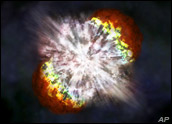
A team of astronomers working with NASA’s Chandra X-Ray Observatory has witnessed the brightest supernova ever seen, leading them to suggest that a similar explosion may be imminent in a star in our own galaxy.
“This supernova was not only bright, but also rather slow in its development, which means that when you take into account that it stayed bright for as long as it did, it was extraordinarily energetic,” Mario Livio, a senior astrophysicist with the Space Telescope Science Institute, told TechNewsWorld.
The death of a star in the galaxy NGC 1260, some 240 million light years away, produced the supernova, known as “SN 2006gy.” The star is thought to have been massive — more than 100 times the weight of our own sun.
A Glimpse Back in Time
“This was a truly monstrous explosion, a hundred times more energetic than a typical supernova,” said Nathan Smith of the University of California at Berkeley, who led a team of astronomers from California and the University of Texas at Austin. The researchers’ findings will be published in The Astrophysical Journal.
“That means the star that exploded might have been as massive as a star can get, about 150 times that of our sun,” Smith said. “We’ve never seen that before.”
The first generation of stars were similarly massive, astronomers believe, so this new supernova may provide a rare glimpse at how the first stars died.
“We know this wasn’t one of the first stars, but we think it may be the same type of mechanism by which the first stars exploded,” Smith told TechNewsWorld.
How Stars Die
When a star dies, one of two things typically happens, Paul Czysz, professor emeritus of aerospace engineering at St. Louis University, told TechNewsWorld.
One possibility is that the star becomes a cold, heavy and dense neutron star, one teaspoon of which would weigh as much as a fully loaded 18-wheeler truck, Czysz said. The other is that it collapses into a black hole, which then sucks away roughly 95 percent of the star’s heavy elements — such as iron, cobalt and uranium — leaving only the lighter materials, such as hydrogen and helium, to escape in the explosion.
The brightness of SN 2006gy indicates that the majority of the heavy elements must have still been present at the time of the explosion, which has never before been viewed. “This is the first supernova they’ve seen that’s neither neutron star nor a traditional supernova,” Czysz explained. “Its characteristics don’t match any other supernova we’ve seen.”
If the first stars exploded in a similar manner, this may help explain where the heavy elements that make up rocky planets such as Earth may have come from — a question astronomers have long been puzzled by, given that most supernovas release only the lighter gases.
The James Webb Space Telescope, a successor to the Hubble Space Telescope that’s scheduled to launch in 2013, may be able to detect some of those first stars, Smith added. “This was very encouraging, because it was so bright,” Smith said. “If the first stars did explode by the same mechanism, we may be able to see them.”
Coming Soon?
Before it exploded, the star that produced SN 2006gy apparently expelled a large amount of mass, leading astronomers to wonder if the same type of explosion might be imminent closer to home.
Eta Carinae, a massive star only 7,500 light years away in the Milky Way galaxy, has exhibited a similar loss of mass, suggesting that it may be poised to explode as a supernova sooner than was otherwise thought.
“The star we think exploded might have been very similar to Eta Carinae in our own galaxy,” Smith said. “The supernova is teaching us a very important lesson about stellar evolution, and how the most massive stars die. Eta Carinae is telling us it might be ready to explode, and previously we would not have thought so.”
Greatest Show in History
If Eta Carinae were to explode in a similar fashion, it would be the brightest thing in the sky — visible even during the day, Smith explained.
Though theoretically such an explosion could pose a risk to Earth in the form of a beam of gamma rays, astronomers do not believe that is likely to happen, he added. “We have more pressing worries, like global warming,” he said.
“We don’t know for sure if Eta Carinae will explode soon, but we had better keep a close eye on it just in case,” Livio said. “Eta Carinae’s explosion could be the best star show in the history of modern civilization.”






















































I was enjoying a late evenig walk last night at about 10:30 when I noticed a brilliant pinpoint of light high in the southeastern sky. This light was unquestionably the brightest object in the sky and lasted only 10 seconds as it faded gradually and could no longer be seen. At its highest brilliance, there were needle sharp rays eminating in all directions from it. I was somewhat disappointed this morning when
both my wife and I could find no reference in the news regarding what clearly to me was a major celestial event that should have been seen by many people and detected by the scientific community.